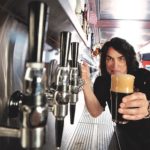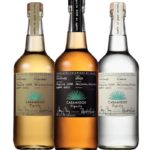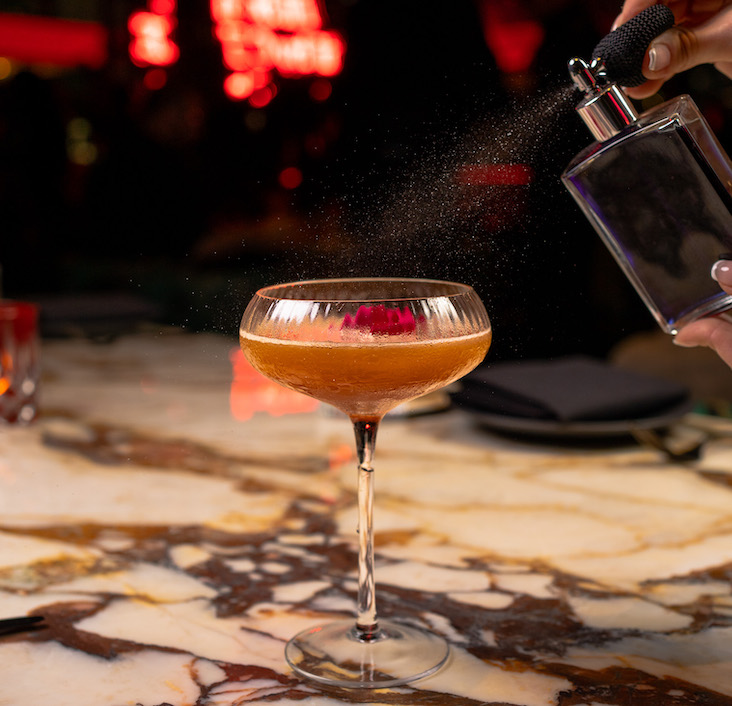More than 20% of consumers make their cocktail decisions based on the menu, according to research from the Beverage Information Group (Cheers’ sister company.) So if you don’t have a drinks list—or you don’t have a good one—you could be leaving money on the table.
Where do you start when creating or improving a cocktail menu? Put together a balanced assortment, says Evan Charest, corporate mixologist for the Patina Restaurant Group, which operates about 60 locations across the country.
“A good balance not only means a nice combination of more boozy aromatics, along with lighter, more refreshing shaken cocktails, but also a wide selection of base spirits, an awareness of seasonality and a mix of more accessible and more advanced choices for the guest,” he says.

A pisco menu at Ray’s and Stark Bar in Los Angeles highlights the South American unaged brandy with sips like a Chile Pisco Margarita ($13), with pisco, Ancho Reyes chile liqueur and lime with a fire-salt rim.
Patina Restaurant Group includes Ray’s and Stark Bar in Los Angeles, a 152-seat, modern American restaurant and craft cocktail bar, respectively. Ray’s and Stark Bar feature 16 cocktails priced from $11 to $14 on a menu that changes seasonally and is tweaked constantly. Categories include shaken, stirred, frozen, shandy, aged, draft and specialty drinks.
Current favorites include Ray’s Swizzle ($13), with Old Forester bourbon, lemon, honey, ginger syrup and bitters over crushed ice, and Oaxaca Meets Italy ($13), made with mezcal and Campari shaken with agave and lime and served up. Draft cocktails include a Blood Orange Moscow Mule and a Hemingway Daiquiri (both $11). A pisco menu highlights the South American unaged brandy with sips such as a Chile Pisco Margarita ($13), with pisco, Ancho Reyes chile liqueur and lime and a fire-salt rim.
Charest says that you have to consider your operation’s volume when creating a cocktail menu. “We move a lot of drinks at Stark Bar; some cocktails simply won’t work because of the length of time it takes to create them,” he notes. Pre-batching and draft libations can help alleviate this challenge, but “it’s a delicate balancing act.”
Context also influences what goes on a menu. Ray’s and Stark Bar’s location at the Los Angeles County Museum of Art (LACMA) means that artists and their artwork tends to influence staff. “Their creativity has animated us to explore different avenues when it comes to our cocktails,” says Charest, from unique flavor combinations to fun infusions.
“A balanced cocktail list means having an equal representation of spirits, a balance of flavors and a good marriage to the elements of the restaurant or bar,” says Darlene Marcello, vice president of food and beverage and procurement at Grayson Social, a 120-seat modern southern concept in Dallas. “You achieve this by much research and development and listening to the feedback of your guests.”
Grayson Social offers 30 cocktails, which range in price from $5 (during happy hour) to $15. Marcello points out that many of the drinks contain creative elements including infused spirits and ice, dehydrated ingredients, tinctures and fermentation.
For instance, the Beef & Bourbon ($15), with Texas bourbon, maple and honey, is enhanced with myrrh and cypress essential oils and garnished with beef jerky. The Rosé Sangria ($15), with Kung Fu Girl rosé and lavender and rose syrups, is infused with collagen and garnished with house-made rosé gummy bears.
1) Map it Out
At Midnight Rambler, a 100-seat rock ’n’ soul craft cocktail salon inside The Joule Hotel in Dallas, co-creator Chad Solomon takes a methodical approach to revising the menu every three months. The list typically offers about 13 cocktails priced from $12 to $15, with an additional six on the Twine Time (happy hour) menu priced $8 to $10.
“I always start by mapping out the menu by defining how many total drinks, which styles of drinks, the service formats (glassware and ice styles) and then creating a flavor bank that is seasonally appropriate and on-concept for that menu,” Solomon says. He then goes back to the drawing board to make all this come to life, taking pour-cost goals, drink prices and guest preferences into consideration.
A recent menu included a flavor key, with descriptors such as “aromatic,” “effervescent,” “passion fruit” and “cherry”; drinks had images corresponding to their main flavors. The Cuffs and Buttons ($14, “aromatic” and “peach”), combines spiced bourbon, stone fruit, acacia honey, creole bitters and lemon zest. The Infinite Loop ($12, “sour-based” and “apple”) has unaged apple brandy, bourbon, Macintosh apple, lemon, mineral syrup, egg white, chamomile and hay essence.

Grayson Social in Dallas offers 30 cocktails, including the Beef & Bourbon ($15), with Texas bourbon, maple and honey, enhanced with myrrh and cypress essential oils and garnished with beef jerky.
2) Keep Descriptions Brief
“We keep our descriptions somewhat short, as we want a certain element of wonder, which will then lead to surprise when the drink is presented,” says Benjamin Schiller, beverage director of The Fifty/50 Restaurant Group in Chicago.
One of Fifty/50’s seven concepts is the 50-seat hip cocktail bar The Sixth, which features 12 to 15 to cocktails at any given time, priced $12 to 15. The menu gets an overhaul every three months and minor adjustments monthly.
The Sixth generally lists the base spirit, dominate flavor elements, and at least one interesting item. The Dream of Spring cocktail ($13) lists Tito’s vodka, grapefruit lemon crème, basil blossom and mint powder; Fitz Loves Olivia ($13) has Tanqueray gin, lemon, cucumber and absinthe, garnished with a cotton candy cloud made with rosewater and rosé wine.
“We use creativity when creating the cocktails, but strike a balance by simply listing ingredients [and letting them] do the talking,” says Priscilla De Luna, bartender at Up & Up. The 70-seat cocktail den in New York offers 110 to 15 cocktails priced $14 to $16 on a menu that’s updated seasonally.
The Whisper Song ($15) lists Letherbee Autumnal gin, Suze gentian liqueur, Kimmel herbal liqueur, beet, ginger and lemon. The drink is served with a rosemary sprig garnish tucked into a lemon peel and set on the rim of a glass in a way that De Luna compares to a feather on a hat.

The Infinite Loop cocktail at Midnight Rambler in Dallas, made with unaged apple brandy, bourbon, Macintosh apple, lemon, mineral syrup, egg white, chamomile and hay essence, is described on the menu as “sour-based” and “apple.”
3) Forgo the Flowery Prose
Chad Spangler, partner at the 40-seat Service Bar in Washington, D.C., agrees that eschewing overly flowery language is the way to pull guests into a cocktail list. “It’s always okay to list or note on the menu anything that helps a guest understand or appreciate what they are about to consume,” he notes. “But trying to be too poetic can be flat out annoying—especially given that one person’s story or interpretation of the cocktail may not fit everyone’s palate.”
Service Bar offers about 55 original cocktails, priced $7 to $80 for the communal bowl drinks, on a list that’s updated on a weekly basis. The menu sticks with main ingredients and a key to help guests visualize how the drink is served (Collins, coupe, rocks glass, crushed ice) and/or what style it is (“Hot!!!”, “mostly alcohol, like a Manhattan,” “spicy,” “dairy,” “nuts” or “carbonated.”)
The main ingredients listed should be detectable, Spangler says, but you don’t need to include the minor players. For instance, Service Bar Samantha cocktail ($12) contains coriander, but it’s in a supportive role, so just vodka, Aperol, cranberry and yuzu are listed on the menu.
Charest believes in transparency with drink descriptions. For his Levitation cocktail ($13), he just lists the key ingredients— gin, mezcal, maraschino, lime and jalapeno—rather than describe it as “smoky, spicy, citrus-forward” on the list.
“Many people do not like spicy, and some have a resistance to mezcal,” he points out. “At the same time, spicy is a nonspecific term: How spicy? Ginger spicy? Chile?” One guest’s “spicy” is the next guest’s “refreshing,” Charest adds.
4) Name Your Drink
“Our cocktails’ names come from whatever inspires us, whether it’s two characters on a Netflix series, or a song lyric, or whatever pops into our heads,” Schiller says.
Seasons 52, a 40-unit grill and wine bar chain from Orlando, FL-based Darden, is partial to drink names that balance whimsy and directness, says executive chef Jim Messinger. The chain offers 10 to 15 drinks at any given time (priced from $9.50 to $13.50, depending on the market), refreshed seasonally.
The Bourbon Berry Bramble is a fun name that also describes what’s in the glass, Messinger says: Maker’s Mark bourbon, St. Germain elderflower liqueur, raspberries, blackberries and lime.
The Botanical Buzz has Prairie Organic vodka, honey and lemon, garnished with the unique buzz button flower, a natural analgesic that gives the imbiber a tingling, buzzing or numbing sensation when it’s consumed.
Whimsy is also the game of the name at The Chemist (whose menu is pictured atop), a 75-seat scientific-themed bar and restaurant in Myrtle Beach, SC, that offers 17 craft cocktails priced from $9 to $12.
“We try to use alliteration based on the ingredients in the drinks, so that people know from the name what flavors to expect,” says The Chemist’s general manager Dan Weaver. “We also use science references that are fun and interesting.” The Periodically Peach Martini ($10) mixes Dixie vodka with Boss elderflower liqueur, peach simple syrup and orange juice, served smoking with dry ice.
On previous versions of the menu, lengthy descriptions led guests to often ask servers what was in the drink; the latest list keeps things simpler, leaving the fun plays on words to the names.
5) Don’t Get Too Technical
There are some terms that should be banished from cocktail descriptions, says Stephan Mendez, bar manager at the 400-seat rooftop bar Paramour in San Antonio, TX. For instance, he’s not a fan of certain words that convey a drink’s sweetness.
“You need to give the guests the best impression of the drink without being overbearing,” he explains. “List what you want them to taste, and don’t use turn off words like ‘sugar’ and ‘syrup.’”
Paramour’s menu is updated three times a year and features 12 house cocktails priced $10 to $12. The Down South Smash ($12) mixes bourbon with lemon, mint and a sweet-tea syrup (listed as “sweet tea” on the menu). A proprietary pecan orgeat syrup goes into both the Julep variation You Can’t Handle the Proof ($12), and the Just a Friend ($10), with Jamaican rum, sherry, citrus and pecans; the word “syrup” is omitted on the list.
Solomon, along with partner Christy Pope, designed a back-bar lab that functions as Midnight Rambler’s flavor house. Tools such as a Hettich centrifuge, Buchi rotavapor, chamber vacuum machine and immersion circulator bath enable the duo “to push the bounds of flavor and aroma.” Every drink uses something from the lab, from a sous-vide infusion to a bespoke aromatic essence.
But they are careful not to alienate patrons with esoteric science terms, referring instead to tastes they can expect. “We intentionally leave out anything overtly technical that can overly intellectualize what should be a fun imbibing experience,” Solomon says.
6) Incorporate Local and Seasonal Ingredients
An integral component of Service Bar’s cocktail program is the use of clarified juices and seasonal ingredients, as well as regional and themed menus. Bartenders use a centrifuge to clarify juices for all carbonated drinks, which are force-carbonated in 1-liter bottles or in a corny keg, and used in libations such as the Tom Collins ($7), with gin, clarified lemon, water and salt.
Seasonal produce sourced from farmers’ markets appears in sips such as Green Leaf ($11), with kale frozen with liquid nitrogen then powdered with a muddler, gin, salt tincture, pepper tincture and lemon. A regional section of the menu, which changes every two months, “has really allowed us to explore the culinary influences of a particular region and in turn, implement those ingredients and techniques in the cocktails,” Spangler says.
The first region, New Orleans, incorporated lemon, pineapple, coffee, herbes de Provence and Cajun spices. Service Bar’s new riff on a Pat O’Brien’s Hurricane ($15) uses fresh strawberries, pineapple, mango, dried hibiscus and fresh passion fruit pulp.
In the end, remember that the cocktail menu and what it conveys—from the name of the drink to what’s in it and how it’s garnished—is often the initial impression of your concept, and what’s focused on first, says Mendez. “Let it lead the example of what should be an amazing experience at your establishment.”
7) Show Off Great Glassware and Garnishing
Most operators agree that a drink’s vessel is super important, and menu keys often clue in guests to the type in which their drink will arrive to the table. “Glassware is…literally the only thing between the liquid cocktail and the guest,” says Benjamin Schiller, beverage director of The Fifty/50 Restaurant Group in Chicago. Fifty/50’s bar The Sixth sources its glassware from a mixture of distributors, antique shops and artisanal craftsmen.
At The Chemist, a scientific-themed bar and restaurant in Myrtle Beach, SC, cocktails may be served in smoking beakers and wine is poured from a chemistry flask. The Radioactive Coke ($9) with Luxardo-infused Maker’s Mark bourbon, is served in a slanted glass.“The right kind of glass and ice impacts taste,” says Evan Charest, corporate mixologist for the Patina Restaurant Group. “Not only that, but we drink with our eyes (and often with our phones and Instagram accounts), and the look of a drink is just as important as [how] it tastes.”
Charest believes that the company’s Stark Bar sells a lot of its Ray’s Swizzles because of how the cocktail is presented: in a tall Collins glass filled with crushed ice, with Angostura bitters forming a crown on top and a bushel of fresh mint as a garnish.
Kelly Magyarics, DWS, is a wine, spirits and lifestyle writer and wine educator in the Washington, D.C. area.
For more on cocktails menus, see Creating Dynamic Drink Menus.






